Kaohsiung Native Mountain Tea/高雄原生山茶
Kaohsiung Native Mountain Tea
◎English translation: Peng Hsin-yi
◎Photos by Pao Chung-hui
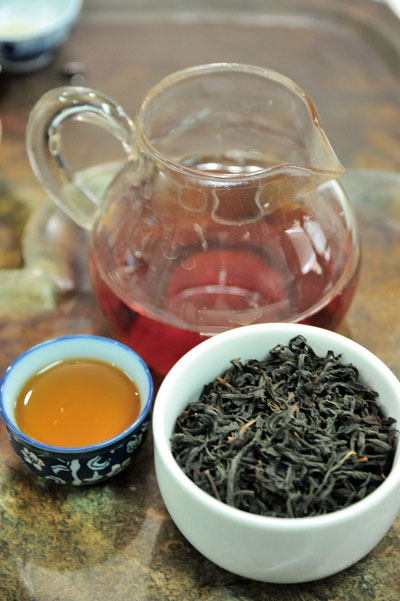 The Kaohsiung native mountain tea tree is a very special plant. Its leaves, after being processed, become a versatile yet enduring tea that can be made into a hot beverage by the traditional tea-making technique or the "cold soak" technique. Cold-soaked tea has a distinctive leafy fragrance that speaks of mountains and misty dews. It quenches the thirst, and brings a sense of rejuvenation. The leaves can be re-soaked several times and still produce satisfying tea. When using hot water, the tea can be light and refreshing, or rich with a powerful aroma, depending on the techniques employed during the leaf-processing stage. The flavor has depth, and reveals multiple layers as one takes sips. The hot tea is never bitter; it leaves a sweet aftertaste as it goes down. As the native tea tree grows only on those steep slopes frequently enveloped by fog, their rarity make them much sought after by those in the know.
The Kaohsiung native mountain tea tree is a very special plant. Its leaves, after being processed, become a versatile yet enduring tea that can be made into a hot beverage by the traditional tea-making technique or the "cold soak" technique. Cold-soaked tea has a distinctive leafy fragrance that speaks of mountains and misty dews. It quenches the thirst, and brings a sense of rejuvenation. The leaves can be re-soaked several times and still produce satisfying tea. When using hot water, the tea can be light and refreshing, or rich with a powerful aroma, depending on the techniques employed during the leaf-processing stage. The flavor has depth, and reveals multiple layers as one takes sips. The hot tea is never bitter; it leaves a sweet aftertaste as it goes down. As the native tea tree grows only on those steep slopes frequently enveloped by fog, their rarity make them much sought after by those in the know.
In Kaohsiung, most high-elevation mountain teas are cultivated in Tauyuan District, but it is the neighboring Sinfa Village in 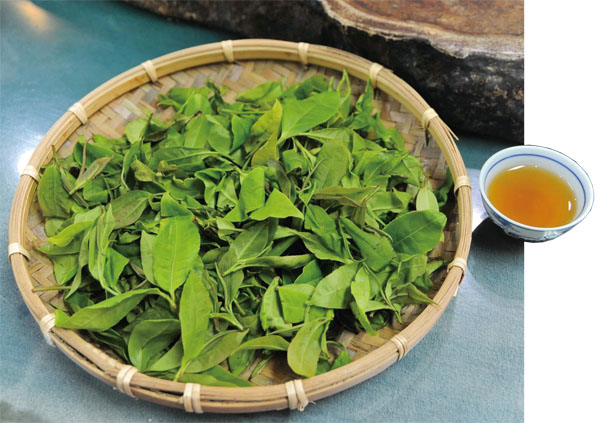 Liouguei District that has mastered tea-leaf processing techniques. Together, these two districts have struck a "green gold mine." Tea cultivation in this area started during the Japanese colonial period. Tea trees were planted in the native forests and grew slowly under the comfortable shade of taller trees. The best tea grows between 1,000 and 1,500 meters above sea level. Tea farmer Du Chun-fu and his wife Gu Shu-hua took over a native-tea plantation seven years ago from Du's father. He says old Mr. Du gathered his starter tea trees from a remote mountain, and transplanted the tea saplings he found there to his farm. The native tea trees do not need any special care and do not need to be fed with fertilizer. Following his father's path, Mr. Du also starts with saplings, serving as their guardian for the following four years, watching over the tea trees as their roots grow deeper and stronger. They are never sprayed with chemicals. Tea trees grown in this fashion are as natural as they come, which also means when the leaves are ready for harvesting, they do not appear in batches.
Liouguei District that has mastered tea-leaf processing techniques. Together, these two districts have struck a "green gold mine." Tea cultivation in this area started during the Japanese colonial period. Tea trees were planted in the native forests and grew slowly under the comfortable shade of taller trees. The best tea grows between 1,000 and 1,500 meters above sea level. Tea farmer Du Chun-fu and his wife Gu Shu-hua took over a native-tea plantation seven years ago from Du's father. He says old Mr. Du gathered his starter tea trees from a remote mountain, and transplanted the tea saplings he found there to his farm. The native tea trees do not need any special care and do not need to be fed with fertilizer. Following his father's path, Mr. Du also starts with saplings, serving as their guardian for the following four years, watching over the tea trees as their roots grow deeper and stronger. They are never sprayed with chemicals. Tea trees grown in this fashion are as natural as they come, which also means when the leaves are ready for harvesting, they do not appear in batches.
Kaohsiung native mountain tea leaves can be harvested three times a year. This winter harvest is the smallest and rarest of the harvests. By April, the trees are again covered in new leaves, enough to paint the whole slope a delicate pale green. This spring harvest is the year's largest in terms of volume. The autumn harvest takes place in October and November.
Native mountain tea is precious not only because of its flavor, but also because of the great amount of work involved. When working in their field, Mr. Du and his relatives must first tie a rope around their waist, with the other end secured to a tree. This is how they stop themselves from falling on the mountain side. During the summer the work is especially arduous due to the humid heat. But Mr. Du is deeply satisfied when he can share this treasure with the world.
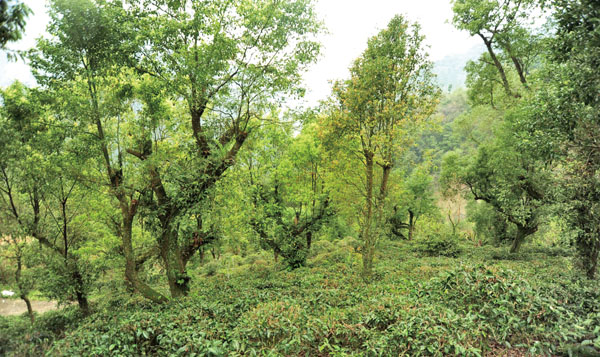 Tea-leaf harvesting is only half of the work; the rest lies in the hands of experienced tea masters. They are the people who oversee the roasting process, making sure the leaves release their fullest potential and present their best flavor. Mr. Liu Wen-hua is a tea master with over 30 years of experience, and the maestro locals look up to. It was him who taught the area's farmers to spread out the tea leaves for aeration, stressing they should not overlap or smother one another, and that the leaves must be delivered from tree to roasting shop within half an hour. Mr. Liu says high-elevation native tea leaves are best treated with high temperatures to coax out the honey fragrance and lovely amber color. But with low-elevation native tea (1,000 meters and below), Mr. Liu can produce a very special brand of black tea. A two-stage fermentation process is used. During the first round the tea leaves lose their excess moisture and astringent taste, while during the second round of fermentation the tea develops its unique sweetness. Tea brewed from these leaves comes out a lovely shade of rose red, with a hint of honey fragrance. All the layers and multiple flavors unique to mountain teas emerge fully intact.
Tea-leaf harvesting is only half of the work; the rest lies in the hands of experienced tea masters. They are the people who oversee the roasting process, making sure the leaves release their fullest potential and present their best flavor. Mr. Liu Wen-hua is a tea master with over 30 years of experience, and the maestro locals look up to. It was him who taught the area's farmers to spread out the tea leaves for aeration, stressing they should not overlap or smother one another, and that the leaves must be delivered from tree to roasting shop within half an hour. Mr. Liu says high-elevation native tea leaves are best treated with high temperatures to coax out the honey fragrance and lovely amber color. But with low-elevation native tea (1,000 meters and below), Mr. Liu can produce a very special brand of black tea. A two-stage fermentation process is used. During the first round the tea leaves lose their excess moisture and astringent taste, while during the second round of fermentation the tea develops its unique sweetness. Tea brewed from these leaves comes out a lovely shade of rose red, with a hint of honey fragrance. All the layers and multiple flavors unique to mountain teas emerge fully intact.
From its origins to its cultivation and then processing, Kaohsiung's native mountain tea is the epitome of quality and taste.
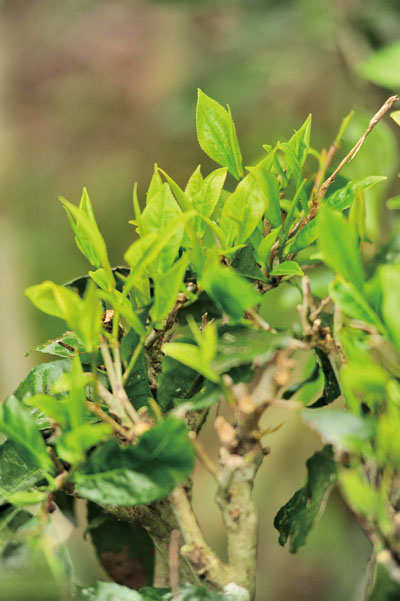 高雄原生山茶
高雄原生山茶
◎文/侯雅婷
◎攝影/鮑忠暉
高雄原生山茶茶湯風味獨特,冷泡有高山野味香氣,喝來生津止渴,茶葉耐沖泡,可沖泡數回。熱沖時,依製茶風格不同而呈現清新或濃郁,均帶有層次豐富的高山風味,茶湯回甘且不苦澀。山裏終年雲霧繚繞孕育出的原生山茶,產量不大令愛好者趨之若騖。
高雄桃源區為高海拔原生山茶產區,與鄰近六龜區新發里製茶產業相輔相成,成為炙手可熱的「綠金」。當地種茶始於日治時代,茶樹與原始林混生,靠著原始林遮蔭。生長於海拔1000至1500公尺的原生山茶,品質格外出色。茶農杜春福和太太古淑花7年前接手父親的原生山茶園,他說父親當初從遠方最陡峭的山頂移植原生山茶茶株,這是當地人取得茶株的途徑。原生山茶並不需特別照顧或施肥,因此杜春福讓茶樹自然生長,從茶苗開始種起,生長時,樹根會不斷往下扎根,歷時4年才可採收,因為不噴藥,茶樹參差不齊地長著新葉,他們得四處巡邏,趁鮮摘下。
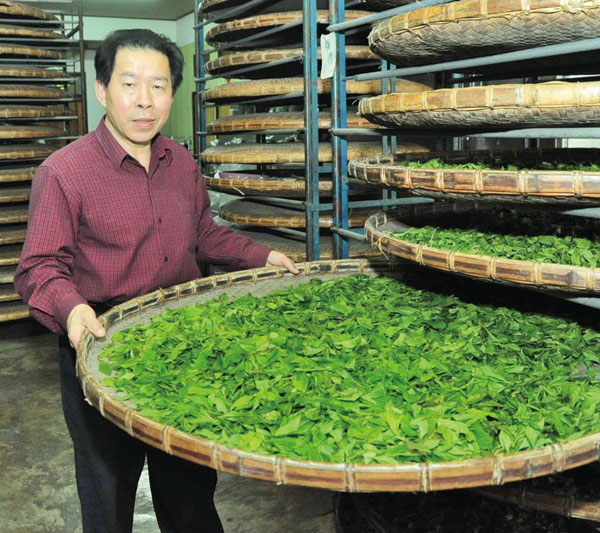 原生山茶一年採收3次,冬茶數量極少,於2至3月採收。春茶產量最大,4月時茶樹佈滿嫩綠新芽,整個山頭綠意盎然,春茶從4月採收至6月。10至11月則為秋茶採收期。
原生山茶一年採收3次,冬茶數量極少,於2至3月採收。春茶產量最大,4月時茶樹佈滿嫩綠新芽,整個山頭綠意盎然,春茶從4月採收至6月。10至11月則為秋茶採收期。
風味獨特的原生山茶得來不易,杜春福一家人無畏艱難地在陡峭的山坡栽種、採收,採收時他們會將繩索繫在身上,接著套在茶樹上,深根的茶樹讓他們安全地在斜坡作業,只是天氣轉熱時,在茶樹間移動,動輒滿身大汗,只為了將山裏最珍貴、也最健康的山茶,推廣給更多人品嚐。
採收下的茶葉得靠製茶師傅運用烘焙技巧,演繹出山茶風味。製茶經驗逾30 年的劉文華是當地人倚重的製茶師傅,為了保持茶葉的最佳狀態,他教育茶農得將茶葉披開,不能讓茶葉悶著,摘採下的茶葉須於半小時內送抵。劉文華說,高海拔的原生山茶適合以高溫烘焙,引出茶葉的濃郁蜜香,呈現琥珀色,倘若是低海拔(海拔1000公尺以下)的原生山茶,劉文華則將它製成獨門的原生酵母紅茶,歷經二次發酵,第一次去除茶青的水份使其不苦澀,二次發酵時,使茶葉產生甘甜口感,有著玫瑰紅色的茶湯,處理得當會帶著輕微蜜香,賦予原生山茶豐富的層次。
高雄原生山茶從產區到製茶產業攜手,產製出讓人豎起大姆指的好品質。